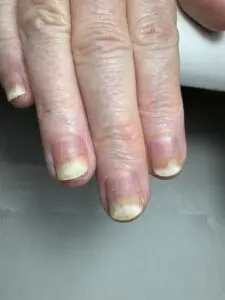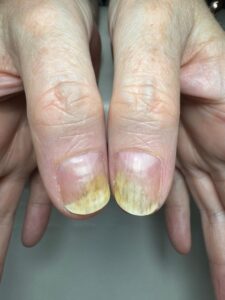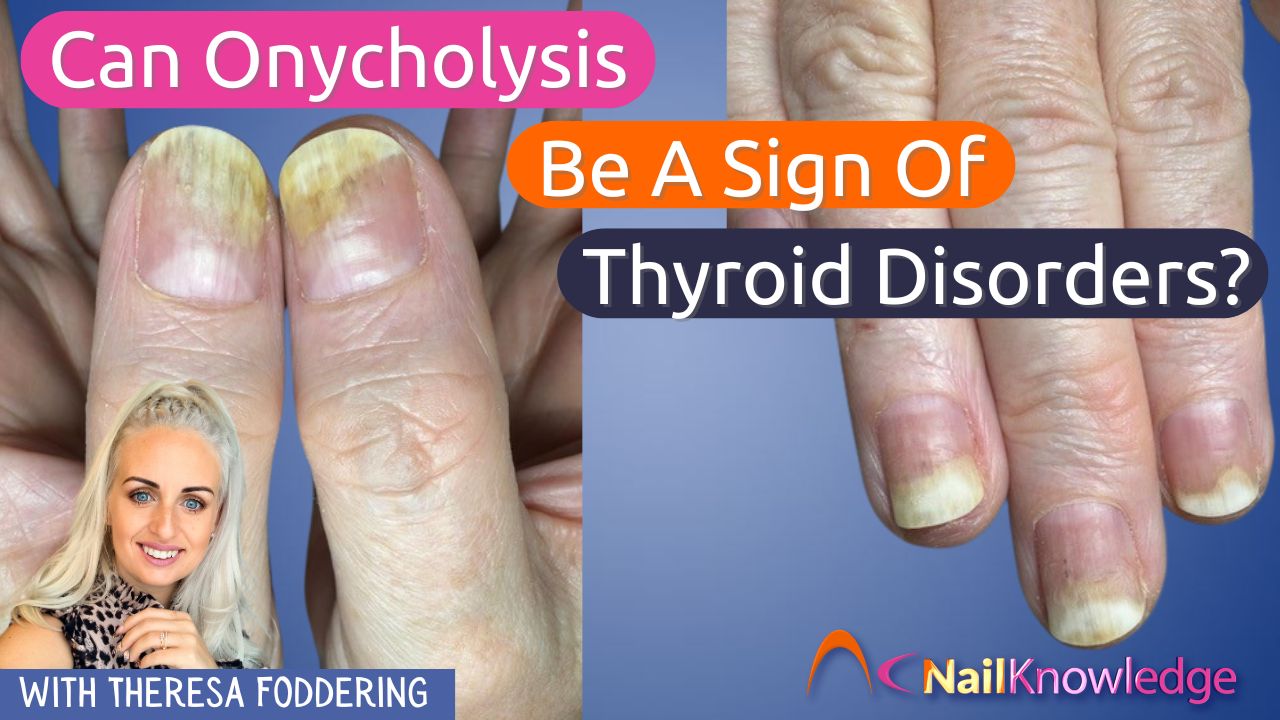Recently, I’ve been assisting a fellow professional with a particularly challenging case of long-standing onycholysis (nail separation). This client also has a history of systemic disorders, latex, and other dermatological allergies, and despite trying various treatments, applications, and products, we cannot pinpoint the root cause. Through persistent research, one issue has stood out, a serious thyroid disorder. This discovery pushed me down the rabbit hole of medical journals and publications to understand the connection between thyroid health and its effects on nails and skin. It’s a habit I’m known for, researching relentlessly to uncover answers, and this time was no different.
What I found was fascinating and deeply relevant to nail professionals. The thyroid gland, often overlooked in our industry, can profoundly affect the nails and skin, presenting signs that may otherwise be dismissed or misdiagnosed. Let’s highlight what I’ve uncovered.


O papel da glândula tireoide
The thyroid gland is a butterfly-shaped organ located in the neck. Despite its size, it’s a powerhouse of activity, producing hormones that regulate nearly every aspect of metabolism. These hormones influence everything from cell growth and repair to energy production, heart rate, digestion, brain function, and more. In short, the thyroid is a ‘master regulator’, ensuring the body operates in balance.
Quando a tireoide não funciona corretamente, esses desequilíbrios hormonais podem causar problemas generalizados, inclusive alterações visíveis nas unhas e na pele. Essas alterações geralmente servem como sinais de alerta precoce de problemas sistêmicos mais profundos.
Hipertireoidismo e hipotireoidismo: As principais diferenças
Hipertireoidismo (tireoide hiperativa)
- A tireoide produz demais hormônio, acelerando o metabolismo.
- Sintomas: Perda rápida de peso, ansiedade, inquietação, intolerância ao calor, fraqueza muscular e afinamento da pele ou dos cabelos.
- Impacto sobre as unhas: Onycholysis (Plummer’s nails) is common, this is where the nail separates from the nail bed, often seen on the middle or ring fingers. Nails may also appear thin and fragile. (Plummer’s Nails only refers to nail separation when caused by thyroid disorders)
- Impacto na pele: Pele suada, quente e fina, propensa a rasgar.
Hipotireoidismo (tireoide hipoativa)
- A tireoide produz muito pouco hormônio, desacelerando o metabolismo.
- Sintomas: Fadiga, ganho de peso, intolerância ao frio, depressão, pele seca e inchaço.
- Impacto sobre as unhas: Brittle, slow-growing nails; vertical ridges; thickened nail plates; and spoon-shaped nails (Koilonychia) in severe cases.
- Impacto na pele: Pele seca, escamosa e áspera; coloração amarelada e demora na cicatrização de feridas.
Distúrbios da tireoide e saúde das unhas
Os efeitos da disfunção da tireoide nas unhas são frequentemente ignorados ou mal atribuídos. Aqui estão algumas alterações comuns nas unhas que devem ser observadas:
- Onicólise (separação das unhas):
Frequentemente associada ao hipertireoidismo, essa condição envolve o descolamento da placa ungueal do leito ungueal. Embora a onicólise também possa resultar de traumas, alergias ou infecções, a disfunção da tireoide é um fator crítico que frequentemente não é levado em consideração. - Crescimento lento e fragilidade das unhas:
Hypothyroidism slows the metabolic processes, leading to slow nail growth and brittle, peeling nails. - Unhas espessadas:
In some cases of hypothyroidism, keratin build-up can cause nails to thicken, creating a rough or irregular texture. - Cumes verticais:
A formação de sulcos proeminentes na placa ungueal pode ser causada pela produção enfraquecida de queratina associada ao hipotireoidismo. - Ressecamento e rachaduras:
Os distúrbios da tireoide geralmente causam uma falta de condição na pele e nas unhas, levando a rachaduras, fissuras e maior suscetibilidade a infecções secundárias.
O quadro geral: Secura, espessamento, cristas e onicólise
One of the most common correlations I’ve observed over the years is the combination of nail dryness, thickening, and ridges culminating in onycholysis. Too often, onycholysis is immediately attributed to an allergic reaction, leading to incorrect advice and missed referrals. While allergies can cause nail separation, it is just one of many potential causes. By becoming overly focused on allergy as the sole explanation, we risk overlooking serious underlying health conditions like thyroid dysfunction.
For example, a client presenting with ridged, brittle nails and onycholysis may be dealing with hypothyroidism rather than an irritant. These signs demand a more holistic assessment and, where necessary, a referral to a healthcare professional.
O que os profissionais de unhas podem fazer?
As nail professionals, our role isn’t to diagnose medical conditions, but we are often the first to notice changes in our clients’ nails and skin. Here’s how we can support them:
- Reconhecer os sinais:
Informe-se sobre os efeitos visíveis da disfunção da tireoide nas unhas e na pele. Preste atenção a padrões como crescimento lento, unhas espessas ou onicólise persistente.
- Evite tirar conclusões precipitadas:
Don’t immediately attribute nail separation to allergies or external factors. Consider the bigger picture, including systemic health issues.
- Personalize seus tratamentos:
Provide gentle, conditioning treatments to combat dryness and brittleness. Avoid aggressive, or even unnecessary, filing or buffing, which could swiftly worsen the problem.
- Incentivar a consulta profissional:
Se você suspeitar de um problema subjacente na tireoide ou de qualquer possível distúrbio sistêmico, sugira que o cliente consulte o médico.
Sempre olhe abaixo da superfície
Os distúrbios da tireoide são mais comuns do que muitos de nós imaginamos, principalmente entre as mulheres com mais de 40 anos ou aquelas que sofrem alterações hormonais. No entanto, os sinais visíveis nas unhas e na pele muitas vezes passam despercebidos ou são mal atribuídos. Como profissionais, temos uma oportunidade única de reconhecer esses sinais precocemente e orientar nossos clientes para que recebam a orientação correta.
The case I mentioned at the start of this blog is a perfect example. By diving deeper into the possible causes of the client’s onycholysis, we uncovered a possible answer to our journey enabling us to assist her better with every service, not to mention highlighting the Nail Professionals’ expertise and professionalism against her competition but to existing and future clients. This experience reinforced the importance of staying curious, informed, and open-minded when addressing nail and skin abnormalities.
Portanto, da próxima vez que você vir um cliente com onicólise persistente, unhas quebradiças ou pele seca e escamosa, lembre-se de que pode ser mais do que aparenta. E, nesses momentos, sua experiência e orientação podem fazer toda a diferença.
Saiba mais sobre Onicólise e o que causa isso?

